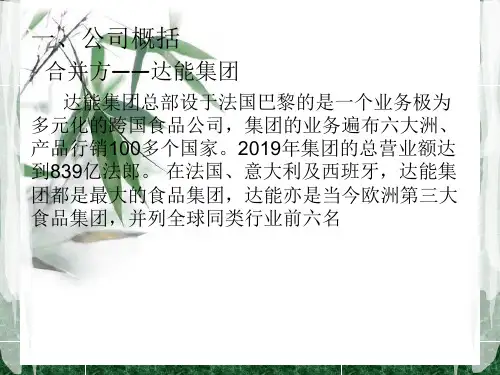达能娃哈哈并购案例分析
- 格式:pdf
- 大小:1.12 MB
- 文档页数:8

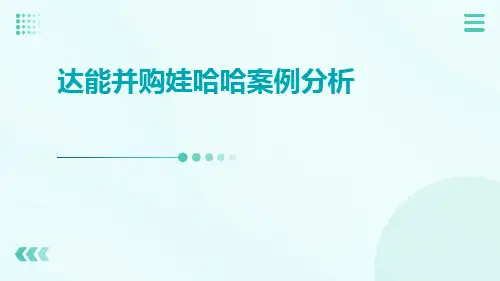
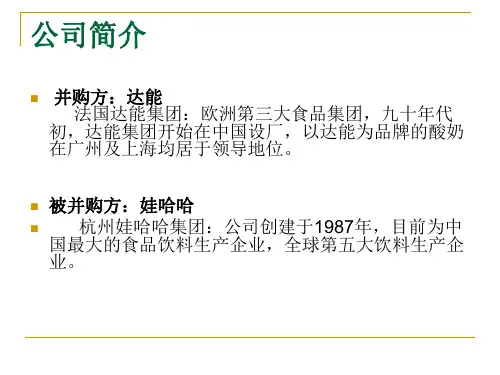
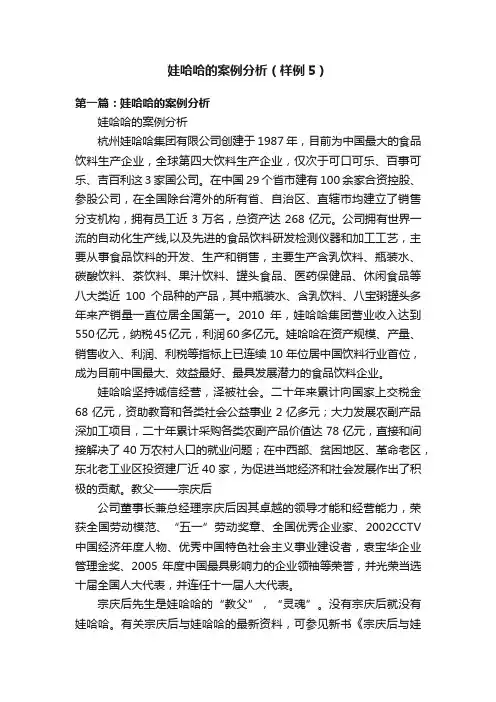
娃哈哈的案例分析(样例5)第一篇:娃哈哈的案例分析娃哈哈的案例分析杭州娃哈哈集团有限公司创建于1987年,目前为中国最大的食品饮料生产企业,全球第四大饮料生产企业,仅次于可口可乐、百事可乐、吉百利这3家国公司。
在中国29个省市建有100余家合资控股、参股公司,在全国除台湾外的所有省、自治区、直辖市均建立了销售分支机构,拥有员工近3万名,总资产达268亿元。
公司拥有世界一流的自动化生产线,以及先进的食品饮料研发检测仪器和加工工艺,主要从事食品饮料的开发、生产和销售,主要生产含乳饮料、瓶装水、碳酸饮料、茶饮料、果汁饮料、罐头食品、医药保健品、休闲食品等八大类近100个品种的产品,其中瓶装水、含乳饮料、八宝粥罐头多年来产销量一直位居全国第一。
2010年,娃哈哈集团营业收入达到550亿元,纳税45亿元,利润60多亿元。
娃哈哈在资产规模、产量、销售收入、利润、利税等指标上已连续10年位居中国饮料行业首位,成为目前中国最大、效益最好、最具发展潜力的食品饮料企业。
娃哈哈坚持诚信经营,泽被社会。
二十年来累计向国家上交税金68亿元,资助教育和各类社会公益事业2亿多元;大力发展农副产品深加工项目,二十年累计采购各类农副产品价值达78亿元,直接和间接解决了40万农村人口的就业问题;在中西部、贫困地区、革命老区,东北老工业区投资建厂近40家,为促进当地经济和社会发展作出了积极的贡献。
教父——宗庆后公司董事长兼总经理宗庆后因其卓越的领导才能和经营能力,荣获全国劳动模范、“五一”劳动奖章、全国优秀企业家、2002CCTV 中国经济年度人物、优秀中国特色社会主义事业建设者,袁宝华企业管理金奖、2005年度中国最具影响力的企业领袖等荣誉,并光荣当选十届全国人大代表,并连任十一届人大代表。
宗庆后先生是娃哈哈的“教父”,“灵魂”。
没有宗庆后就没有娃哈哈。
有关宗庆后与娃哈哈的最新资料,可参见新书《宗庆后与娃哈哈一个著名企业的深度研究》。
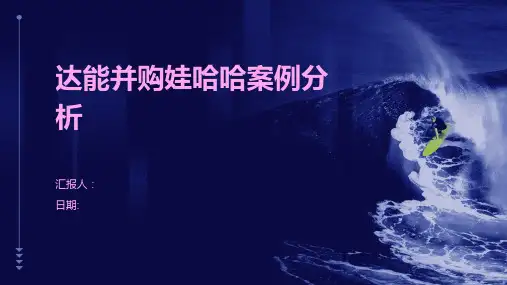
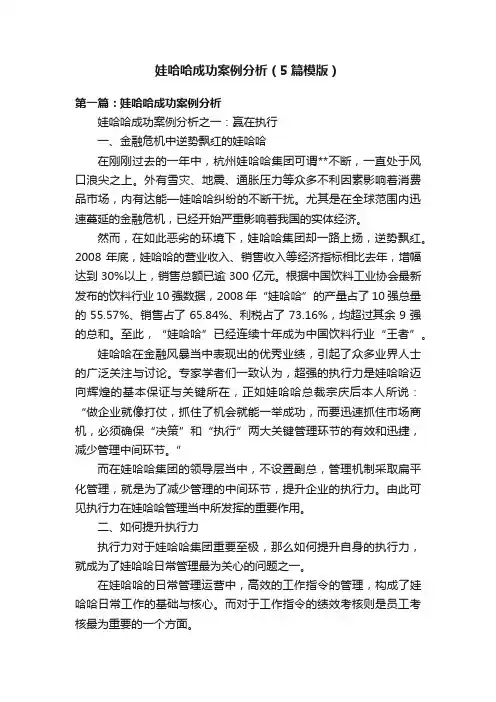
娃哈哈成功案例分析(5篇模版)第一篇:娃哈哈成功案例分析娃哈哈成功案例分析之一:赢在执行一、金融危机中逆势飘红的娃哈哈在刚刚过去的一年中,杭州娃哈哈集团可谓**不断,一直处于风口浪尖之上。
外有雪灾、地震、通胀压力等众多不利因素影响着消费品市场,内有达能—娃哈哈纠纷的不断干扰。
尤其是在全球范围内迅速蔓延的金融危机,已经开始严重影响着我国的实体经济。
然而,在如此恶劣的环境下,娃哈哈集团却一路上扬,逆势飘红。
2008年底,娃哈哈的营业收入、销售收入等经济指标相比去年,增幅达到30%以上,销售总额已逾300亿元。
根据中国饮料工业协会最新发布的饮料行业10强数据,2008年“娃哈哈”的产量占了10强总量的55.57%、销售占了65.84%、利税占了73.16%,均超过其余9强的总和。
至此,“娃哈哈”已经连续十年成为中国饮料行业“王者”。
娃哈哈在金融风暴当中表现出的优秀业绩,引起了众多业界人士的广泛关注与讨论。
专家学者们一致认为,超强的执行力是娃哈哈迈向辉煌的基本保证与关键所在,正如娃哈哈总裁宗庆后本人所说:“做企业就像打仗,抓住了机会就能一举成功,而要迅速抓住市场商机,必须确保“决策”和“执行”两大关键管理环节的有效和迅捷,减少管理中间环节。
”而在娃哈哈集团的领导层当中,不设置副总,管理机制采取扁平化管理,就是为了减少管理的中间环节,提升企业的执行力。
由此可见执行力在娃哈哈管理当中所发挥的重要作用。
二、如何提升执行力执行力对于娃哈哈集团重要至极,那么如何提升自身的执行力,就成为了娃哈哈日常管理最为关心的问题之一。
在娃哈哈的日常管理运营中,高效的工作指令的管理,构成了娃哈哈日常工作的基础与核心。
而对于工作指令的绩效考核则是员工考核最为重要的一个方面。
过去,娃哈哈采取传统的工作指令管理方式方法,存在着诸多的弊病与缺点:(1)效率低下。
无论是工作指令的下达、反馈与评价,都要通过传统的电话、邮件、MSN等方式进行,造成了工作效率低下,且增加成本,容易造成铺张浪费;(2)缺乏实时性。
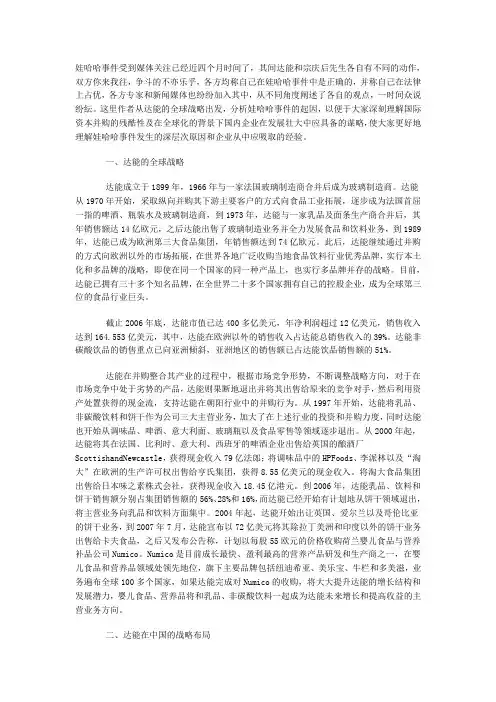
娃哈哈事件受到媒体关注已经近四个月时间了,其间达能和宗庆后先生各自有不同的动作,双方你来我往,争斗的不亦乐乎,各方均称自己在娃哈哈事件中是正确的,并称自己在法律上占优,各方专家和新闻媒体也纷纷加入其中,从不同角度阐述了各自的观点,一时间众说纷纭。
这里作者从达能的全球战略出发,分析娃哈哈事件的起因,以便于大家深刻理解国际资本并购的残酷性及在全球化的背景下国内企业在发展壮大中应具备的谋略,使大家更好地理解娃哈哈事件发生的深层次原因和企业从中应吸取的经验。
一、达能的全球战略达能成立于1899年,1966年与一家法国玻璃制造商合并后成为玻璃制造商。
达能从1970年开始,采取纵向并购其下游主要客户的方式向食品工业拓展,逐步成为法国首屈一指的啤酒、瓶装水及玻璃制造商,到1973年,达能与一家乳品及面条生产商合并后,其年销售额达14亿欧元,之后达能出售了玻璃制造业务并全力发展食品和饮料业务,到1989年,达能已成为欧洲第三大食品集团,年销售额达到74亿欧元。
此后,达能继续通过并购的方式向欧洲以外的市场拓展,在世界各地广泛收购当地食品饮料行业优秀品牌,实行本土化和多品牌的战略,即使在同一个国家的同一种产品上,也实行多品牌并存的战略。
目前,达能已拥有三十多个知名品牌,在全世界二十多个国家拥有自己的控股企业,成为全球第三位的食品行业巨头。
截止2006年底,达能市值已达400多亿美元,年净利润超过12亿美元,销售收入达到164.553亿美元,其中,达能在欧洲以外的销售收入占达能总销售收入的39%。
达能非碳酸饮品的销售重点已向亚洲倾斜,亚洲地区的销售额已占达能饮品销售额的51%。
达能在并购整合其产业的过程中,根据市场竞争形势,不断调整战略方向,对于在市场竞争中处于劣势的产品,达能则果断地退出并将其出售给原来的竞争对手,然后利用资产处置获得的现金流,支持达能在朝阳行业中的并购行为。
从1997年开始,达能将乳品、非碳酸饮料和饼干作为公司三大主营业务,加大了在上述行业的投资和并购力度,同时达能也开始从调味品、啤酒、意大利面、玻璃瓶以及食品零售等领域逐步退出。
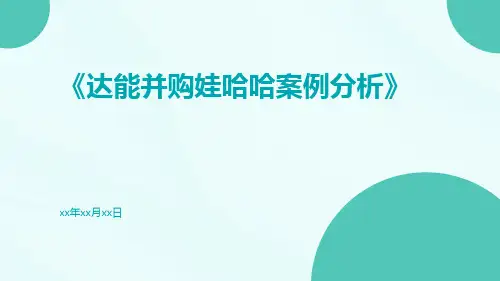
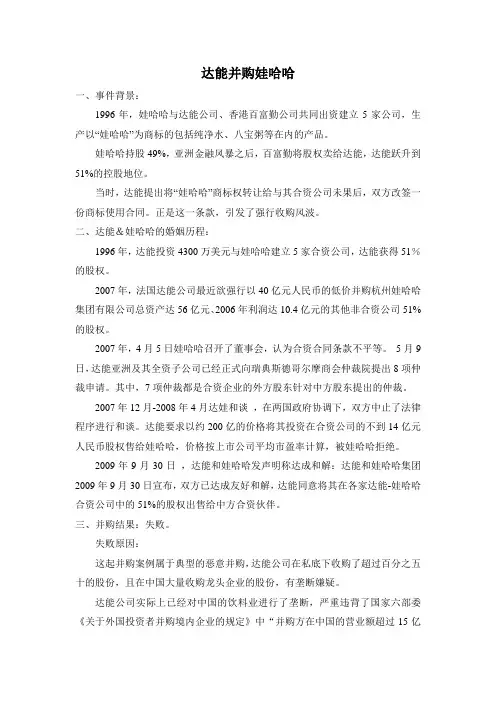
达能并购娃哈哈一、事件背景:1996年,娃哈哈与达能公司、香港百富勤公司共同出资建立5家公司,生产以“娃哈哈”为商标的包括纯净水、八宝粥等在内的产品。
娃哈哈持股49%,亚洲金融风暴之后,百富勤将股权卖给达能,达能跃升到51%的控股地位。
当时,达能提出将“娃哈哈”商标权转让给与其合资公司未果后,双方改签一份商标使用合同。
正是这一条款,引发了强行收购风波。
二、达能&娃哈哈的婚姻历程:1996年,达能投资4300万美元与娃哈哈建立5家合资公司,达能获得51%的股权。
2007年,法国达能公司最近欲强行以40亿元人民币的低价并购杭州娃哈哈集团有限公司总资产达56亿元、2006年利润达10.4亿元的其他非合资公司51%的股权。
2007年,4月5日娃哈哈召开了董事会,认为合资合同条款不平等。
5月9日,达能亚洲及其全资子公司已经正式向瑞典斯德哥尔摩商会仲裁院提出8项仲裁申请。
其中,7项仲裁都是合资企业的外方股东针对中方股东提出的仲裁。
2007年12月-2008年4月达娃和谈,在两国政府协调下,双方中止了法律程序进行和谈。
达能要求以约200亿的价格将其投资在合资公司的不到14亿元人民币股权售给娃哈哈,价格按上市公司平均市盈率计算,被娃哈哈拒绝。
2009年9月30日,达能和娃哈哈发声明称达成和解:达能和娃哈哈集团2009年9月30日宣布,双方已达成友好和解,达能同意将其在各家达能-娃哈哈合资公司中的51%的股权出售给中方合资伙伴。
三、并购结果:失败。
失败原因:这起并购案例属于典型的恶意并购,达能公司在私底下收购了超过百分之五十的股份,且在中国大量收购龙头企业的股份,有垄断嫌疑。
达能公司实际上已经对中国的饮料业进行了垄断,严重违背了国家六部委《关于外国投资者并购境内企业的规定》中“并购方在中国的营业额超过15亿元人民币,境内资产拥有30亿元以上,境内企业超过50家,必须报经国家商务部、国家工商总局审查规定”。
娃哈哈集团&达能集团的经营战略:1、开发新产品,迅速占领市场:八十年代中后期,国民生活水平普遍提高,人们对保健意识逐渐增强。
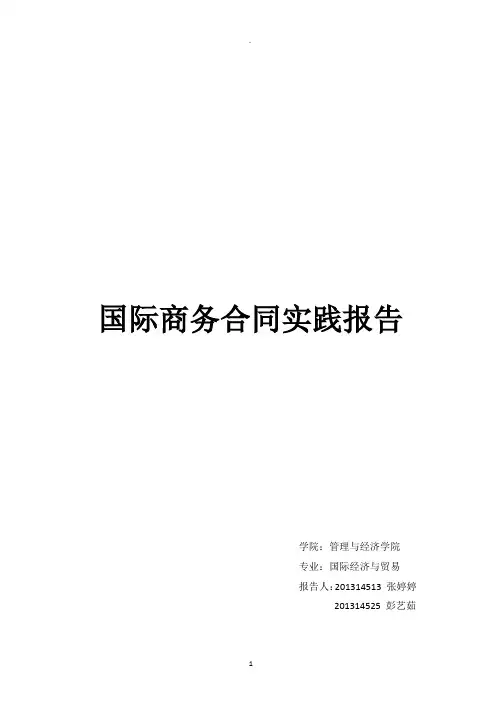
国际商务合同实践报告学院:管理与经济学院专业:国际经济与贸易报告人:201314513 张婷婷201314525 彭艺茹目录一.案例介绍1.1原文介绍1.2原文翻译1.3案例概述二.案例分析三.结局反思一.案例介绍1.1原文介绍:BackgroundIf you are in China,chances are you drink at least one bottle of Wahaha brand water,or perhaps the company’s iced tea,fruit drinks,or its Future Cola.If you go to the United States,you may even come cross Future Cola in New York or Los Angeles,because the company that first set up shop in an elementary school in Hangzhou,Zhejiang,is going global.The Hangzhou Wahaha Group Co.,Ltd.,China’s leading domestic beverage producer,didn’t achieve success overnight.The company’s predecessor,the Hangzhou Shangcheng District School-Run Enterprise Sales Department,funded its start-up operations in 1987 with a government loan.Zong Qinghou,the company’s founder,and two retired schoolteachers initially sold milk products and popsicles out of a school store,but to benefit the student’s health the group soon began producing and selling nutritional drinks.The company’s success selling nutrition products in school led to its first big expansion:with Hangzhou government support,the company acquired a company then changed its name to the Hangzhou Wahaha Group Co.(The word “Wahaha”is meant to mimic the sound of a baby laughing and is taken from a children’s folk song.)Wahaha’s second large-scale expansion occurred in 1994 when the company merged with three insolvent companies in Fulling,Sichuan,to set up its first factory in Chongqing.The Wahaha Joint Venture (JV)was formed in February,1996.At the start,there were three participants in the JV:Hangzhou Wahaha Food Group(Wahaha Group),led by its chairman Zong Qinghou;Danone Group,a French corporation(Danone);and Bai Fu Qin,a Hong Kong corporation(Baifu).In 1996,the two parties signed a trademark tranfer agreement,with anintention to transfer the”Wahaha”trademark to the joint ventures.The move,however,was not approved by the State Trademark Office.For this reason,the two parties signed in 1999 the trademark licensing contract.According to law,the same subject can not be synchronously transferred and licensed the use to others by the same lost.Therefore,the signing and fulfillment of the trademark licensing contract showed that the two parties had connived the invalidation of the transfer agreement.The”Wahaha”brand should belong to the Wahaha Group,while the joint ventures only have right of use.In October,2005,the two parties inked the No.1 amendment agreement to the trademark licensing contract,in which it confirmed Party A(Hangzhou Wahaha Group Co.,Ltd.)as owner of the trademark.In addition,the second provision of the amendment agreement clearly stated that the several Wahaha subsidiaries listed in the fifth annex of the licensing contract as well as other Wahaha subsidiaries(referred to as”licensed Wahaha enterprises”)established by Party A or its affiliates following the signing of the licensing contract also have right granted by one party to use the trademark.The “licensed Wahaha enterprises”involved in the amendment agreement refer to the non-joint ventures.According to related files,Wahaha owns the ownership of the “Wahaha”trademark,while its non-joint ventures have the right to use the trademark.The Danone-Wahaha Feud--Trademark LicenseFrom May,2007 when Danone initiated legal proceeding against Wahaha,the both sides have carried out several dozen lawsuits worldwide.As of May,2009,Danone not only lost a series of cases against Zong Qinghou and the non-joint ventures in China,but directors of Danone were deemed by many courts to have violated the non-compete obligation of directors,and litigations filed in the U.S.,Italy,France and British Virgin Islands(BVI)were alsodismissed.Now,Wahaha defeats Danone 37:0 in the lawsuits in and out of China.The ownership and use right of the Wahaha trademark is one of the focuses of the”Danone-Wahaha feud.”Danone often insisted that the Wahaha trademark belonged to the joint ventures,so the use of the trademark by non-joint ventures constituted infringement.But Wahaha Group disagreed with that,and emphasized that it was the true holder of the trademark,and the use of the trademark by non-joint ventures was legal.At the beginning of the Danone-Wahaha “marriage,” Wahaha signed a transfer agreement on the ownership of the Wahaha trademark with the joint ventures,and filed a trademark transfer application with the State Trademark Office,which,however,was not approved.”It actually declared the termination of the transfer contract,and the Wahaha trademark is still owned by the Wahaha Group,”said Ye Zhijian,a lawyer who knows the case.Afterward,the two parties signed a trademark licensing contract in 1999 to substitute the original transfer agreement.Both the licensing contract and the consequent No.1 amendment agreement clarify that the non-joint ventures of Wahaha have the right to use the Wahaha trademark.“It was known to and recognized by Danone that the non-joint ventures OEM for the joint ventures,so how could it be possible for the non-joint ventures to use a different trademark from the joint ventures?”Ye noted.To confirm the ownership of the Wahaha trademark,Wahaha referred to the Hangzhou Arbitration Commission for arbitration in accordance with the trademark transfer agreement.In December,2007,the commission made a decision that the trademark transfer agreement between Danone and Wahaha had terminated,and the Wahaha trademark belonged to the Wahaha ter,the Hangzhou Intermediate People’s Court affirmed the ruling.1.2 原文翻译:背景如果你在中国,那么你至少喝一瓶娃哈哈品牌水,或者公司的冰茶,果汁饮料,或非常可乐。
